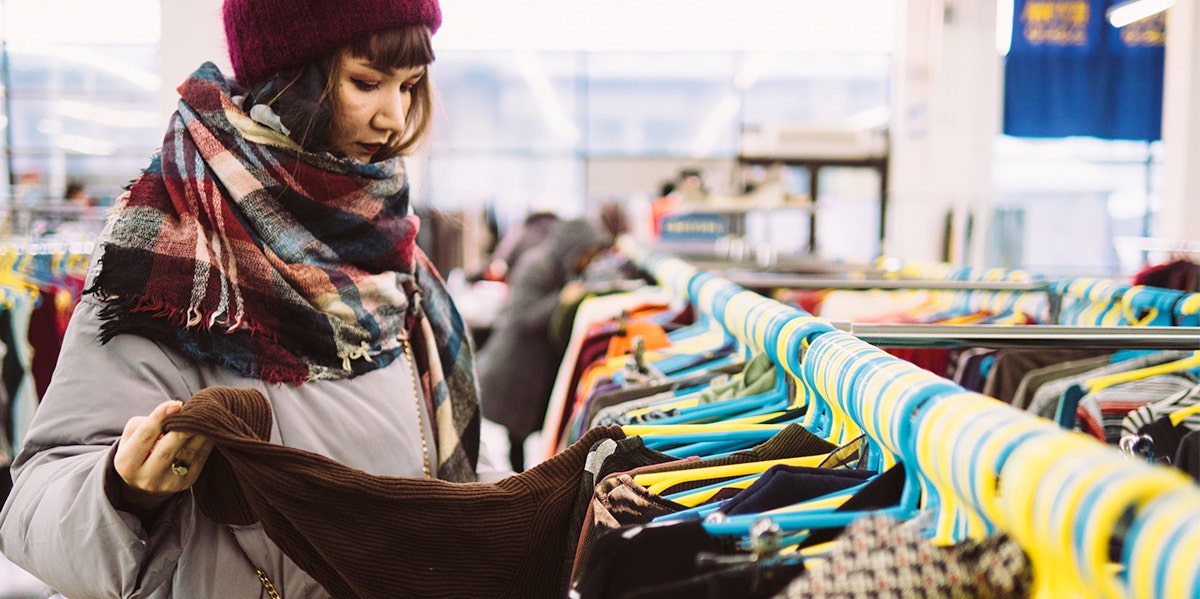Why TikTok’s Thrift Flip Trend Promotes Fatphobia — And Isn't As Ethical As It Looks
Buying and upcycling plus-size clothes takes them away from people who actually need them.
 paulzhuk / Shutterstock
paulzhuk / Shutterstock For plus-size people, the #thriftflip trend on TikTok is making shopping second-hand increasingly inaccessible.
Purchasing second-hand clothing from thrift stores has plenty of perks for the environment and for consumers on a budget.
The fashion industry contributes to 10% of global carbon emissions and shopping from the enormous amounts of already-existing clothing instead of buying new is one of the simplest, most affordable, and most effective ways to offset this.
Some eco-conscious Gen Zers are using TikTok to promote more sustainable fashion choices by showing off their Goodwill finds.
Thrift flipping encourages people to source “oversized” secondhand clothing and upcycle it into something usually cropped and often tight.
The creators of the videos, which have amassed over 750 million views, are usually slim young women who, you can imagine, rarely struggle to find clothing in their size.
But what about the people for whom this clothing isn’t oversized?
Large sizes are not made for smaller, petite people to achieve a baggy look. There are plenty of real people who rely on these sizes in order to dress themselves.
There is an undertone of fatphobia in these videos. The large-sized clothing is portrayed as something in need of a transformation when in reality it is just being worn by the wrong person.
But thrift flipping also perpetuates a problem with accessibility for plus-sized dressers who often struggle to find their size in stores.
YourTango spoke exclusively with Deja Lynch, a fashion influencer with more than 70,000 followers across their socials, about the problem the “thrift flip” trend is contributing to:
“Thrifting is 'accessible' as far as cost goes, but not so much in size. Most clothing stores are less accessible to fat folks. Standard stores have a problem of not stocking enough large and plus-sized clothing, or not having it available at all,” Lynch says.
They also know that size-inclusivity is a pervasive issue across the board in fashion.
These problems were not invented by the sustainable or secondhand fashion industry but rather borrowed from mainstream fashion which has promoted unrealistic body standards for decades.
But this lack of inclusivity seems particularly offensive coming from a trend that claims to take a moral high ground. In order for fashion to be ethical, it must be ethical for all.
“People understand conscious buying as not overbuying or being as eco-friendly as possible. This is true, but there has to be some level of social consciousness as well. Sizing is one of the many factors that must be considered if you are truly thrifting consciously,” Lynch says.
Deja is a regular promoter of thrifting and shopping sustainably through their styling content and hauls.
However, they are less supportive of the thrift flip trend, especially when it is preventing plus-size people from accessing items.
“It is unfair and insensitive for thrift flippers to actively seek out plus-sized clothing only to destroy it and make something they likely could have bought outright in the very same store.”
Lynch also points out that thrifting, while becoming increasingly trendy, is not just beneficial for those looking to make stylish outfits on a budget. “This is not Brandy Melville. There is not one specific type of person who comes here. There is all different kind of people who thrift, for all different types of reasons with all different types of bodies,” Lynch says.
This makes it all the more important for those who are new to thrifting to be conscious of others when they shop. Since there are no manufacturers behind thrift stores, it is up to individual thrifters to make these stores a more size-inclusive place to shop.
“There are other options flippers have. Fabric, linens, drapery are also sold at the thrift. Most of us have forgotten clothes in our own closets that deserve a new life,” Lynch says.
As these short thrift flip videos become more and more popular on TikTok, they also become more detached from their original purpose.
If thrift-flipping was invented to encourage ethical clothing choices, those ethics must be carefully considered with each and every purchase.
“Because many of these tutorials are ridden with hashtags promoting sustainability, I wonder how thoroughly they care about sustainability from the fat perspective,” Lynch says.
Shifting away from supporting fast-fashion is about more than making trendy TikToks. It requires a thorough examination of how fashion consumption damages the greater good both socially and environmentally.
Taking the fatphobia and lack of body diversity that exists in fast-fashion into ethical fashion is both hypocritical and counterproductive.
As Lynch puts it, “Taking perfectly good plus-size clothing and creating scraps under the gauze of upcycling is the least sustainable option. It's almost as if they stopped eating meat but still buy fur.”
Alice Kelly is a writer living in Brooklyn, New York. She is a generalist with an interest in lifestyle, entertainment, and trending topics.

